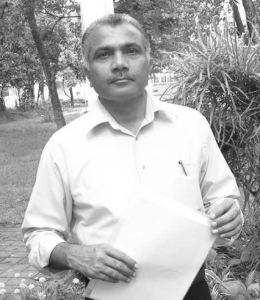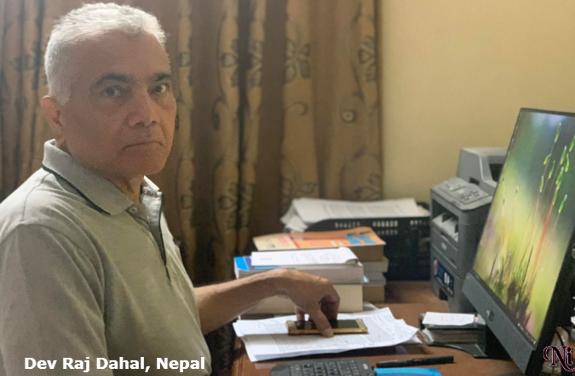Dev Raj Dahal, Kathmandu, Nepal
“The concept of humanity obliges us to take up the “we” perspective from which we perceive one another as members of an inclusive community no person is excluded from” (Habermas, 2003:56) and establishing a framework of justice at every level of society.
“Bringing social justice to global markets requires global institutions to regulate global business, but these institutions are dominated by elites who oppose social justice” (Faux, 2006:24) and tend to escape democratic constraints on their wealth and power.
Regulation of conflicting interests within the civil society is a major policy challenge. Social movements, advocacy groups and even traditional nonprofit associations limit themselves to social action, have failed to increase the society’s productive potential and resolve the dilemma of a larger collective action across various disciplinary boundaries.
Neo-Tocquevilains are correct in submitting the theory that a stable democracy entails a web of common interest and functional rationality of national community—the state. Since civil society alone cannot produce social cohesion and system integration, political parties and the state have a tendency to distrust them, restrict their operation and keep them under clientelist control.
The demise of the Cold War in the 1990s stirred a ray of hope that inter-state wars would recede, a global peace dividend would moderate intra-state conflicts and the ideas of peace and human rights would bring a new understanding of citizenship and of civil society (Kaldor, 1999:3).
The post-Cold War era would mark “no mere adjustment among states but a novel redistribution of power among states, markets and civil society” (Mathews, 2000:534).
In this redistributed regime, the entire international development establishment has made civil society assistance a program priority (Encarnacion, 2003:2). Donors are particularly obsessed with the use of civil society for the promotion of the market economy, democratic transitions, political distribution and institution-building by weaving the democratic pressures of developing societies into a stable civic life.
They are financing the civil society to push for policy reforms, humanitarian aid, post-conflict reconstruction and good governance which they define as the capacity of a state to “protect democracy, function of its politics and its developmental determination” (Leftwich,1996:17).
Four main political reasons prompted the West’s preoccupation with good governance and democracy:
“the legitimization of conditionality (or leverage) as an instrument of policy; the ascendancy of neo-conservative or neo-liberal political economic theories and ideologies in the West; the collapse of the Soviet Union and its client states; and the growth of democratic pressures in some developing countries” (Leftwich,1996:11).
Ironically, many donors have falsely equated NGOs with civil society. Civil society has a broader concern and organizational complexity, such as trade unions, business chambers, producers associations, federations and coalition of various groups and social movements, elements that are missing in the NGO equation.
The increasing NGOization of civil society has atomized mass-based social movements, sapped the civility of society to cooperate even without financial incentives, killed its charity work, enforced external perception of 12 reality and fomented distributional and rights-based conflicts in society.
As a result, NGOs and other sections of civil society are seen competing with one another for aid outlay to fulfill donor criteria to acquire projects.
“Aid providers often imagine the advocacy NGO sector to be a pristine domain, free of the murky ties and tensions of ethnicity, class, clan and political partisanship that make the political fabric so messy and difficult to deal with” (Carothers, 1999:217).
Only a radical reclaiming of the political potential of civil society can be expected to unleash conflict transformation.
But, “a robust civil society can develop only in the context of a liberal political culture and the corresponding patterns of socialization, and on the basis of an integral private sphere; it can blossom only in an already rationalized life-world” (Habermas, 1997:371).
Jurgen Habermas argues that in the context of new social formation where technological diffusion, transnational corporations, global market, media power, ecological issues, human rights, international law and terrorism challenge both the state and civil society, what is required is “communicative action” so that the system can conform the life-world and civic virtues such as reciprocity, cooperation and collective action, to foster democratic development and peaceful resolution of conflict.
The explosive growth of transnational voluntary associations, anti-globalization, environment and women’s rights movements, widespread respect for human rights, flow of remittances, effective communication, advent of global civil society, proliferation of cross-cultural dialogues and transnational rise of citizenship suggest that “some social or communal bonds, a sense of identity and loyalty, are beginning to be formed across national borders” (Etzioni, 2005:131).
International civil society groups increasingly feel that there are international public goods like foreign aid, world peace, global environment, etc which can only be secured through international collective action.
Civil Society, Community and Social Capital Modern society has three basic actors: the state, the market and the citizens with all their informal and formal institutions, networks and movements known as the civil society (Galtung, 1996:36).
The diffusion of power away from the state, however, requires complementary norms, values and interests of these actors to generate social capital and resolve distributional conflicts.
Each of these actors creates its own realm of social life based on a different ordering principle: “the state is built upon coercion, the market upon competition and civil society upon voluntary cooperation” (Skidmore, 2001:3).
Situated between the family and the state, civil society is a multitude of autonomous informal and formal human associations, identities, networks and movements forged for the sake of protecting themselves and others from the arbitrary and unjust decisions of the holders of power and wealth and promoting their rational self-interest (Dahal, 2001:10).
The state and market failures in addressing the problem of the society gave increased donors’ interest in societal variables such as the civil society, community and social capital to shape a strong sense of common identity and purpose and a greater willingness to invest in public goods.
These soft institutions constituted by citizens themselves matter in defining collaboration between the state and the market, putting human interests prior to institutional interests and determining political and economic performance.
They also strengthen the social base of democracy, development and peace. One of the rationales of public debate is to accept the legitimacy of alternative opinions and viewpoints and strengthen social control over the leaders of society.
And, the notion of social capital expunges the narrow ends of development as mere wealth creation.
Strong public institutions of the state, vibrant political parties and a set of voluntary informal associations and relationships capable of moderating the ferociousness of the market’s competing interests are essential to realize the common vision of good governance– security, law and order, voice, participation, public welfare and conflict resolution.
Markets can work well if they are embedded in society and politics because they define and enforce the economic rules including efficient property rights (Williamson, 2001: 93; Halperin, 2004:264).
Market failure produces bad governance, drains social trust, breaks economic transaction and information and even generates social conflicts. The impact of market failure–scarcity of public goods and services, slumps, unemployment, recessions and misery –can be easily detected on political institutions, individual’s quality of life, social cohesion and economic growth.
Civic connections of a myriad of communities, informal institutions and networks with the formal institutions of the state assist in the social coordination of the market forces and moderate their negative impacts.
Peace building requires civil society to carry out a wide range of social responsibilities, link the benevolence of individuals, groups and communities and revitalize the centrality of dialogue necessary to resolve conflict non-violently.
Patterson elaborates four kinds of social capital or trust: a) affective trust based on one-on-one relations between persons and reinforced by norms with strong sanction; b) intermediary trust, which relies on personal characteristics, for estimating the costs and benefits of trusting but works at a distance through intermediaries; c) collective trust, involving situations in which persons have direct, but impersonal, contact with familiar strangers within their midst or humanistic in nature; and d) delegated trust, which depends on third party, institutional guarantees available in modern societies. (1999: 154-157).
Robert D. Putnam defines social capital as “features of social life—networks, norms and trust—that enable the participants to act together more effectively to pursue shared objectives” (1995:665).
It is informal relationships that encourage cooperation among diverse individuals, groups, communities and nation-states, strengthen group cohesiveness and provide critical resources and legitimacy for combating violent conflicts (Bourdieu, 1986; Coleman, 1988, Fukuyama, 1999).
“Social capital is important to the efficient functioning of modern economies and is the sine qua non of stable liberal democracy” (Fukuyama, 1999:1).
Several series of horizontal networks and organizations provide individuals connective tissues, which can be extended to other worthwhile social causes for vertical relations with the state, market and civil society.
In this sense, social capital refers to the “concern for one’s own associates, a willingness to live by the norms of one’s own community and to punish those who do not” (Bowles and Gintis, 2002:1).
Community often generates a consensus of opinion disapproving fraud, deception and free-riding. Conflict transformation, reconstruction and rehabilitation require new forms of social capital that is inclusive and crosscutting across sub-groups of society.
So it is through a set of complimentary interests, values and relationships among the state, the market and civil society that the synergy of social capital is generated for larger public action. Voluntary groups in the community can serve as a check against the market and the state and act upon the common interest of members.
The associational participation of various communities in civil society shapes collective choice, boosts collective efficacy in participation and institutionalization of public life and increases the leverage of citizens in public policy matters.
The liberal state as a representative of the entire society is, therefore, committed to supporting voluntary approaches of the civil society.
Their trust and tolerance embodied in voluntary practices underpin a popular control over the governing elites. A liberal state does not take away those things, which citizens can and want to do for their commonweal.
Withdrawal of citizens from civic engagements drains the social capital necessary to address some common state and market failures. Unmediated by strong civil societies and active states, markets produce growing inequality, social polarization and political instability” (Skidmore, 2001:9).
Social capital is, therefore, instrumental in buffering the unfair outcome of market competition that can easily breed social conflict.

Free individuals need a community, “which backs them up against encroachment by the state and sustains morality by drawing on the gently prodding of kin, friends, neighbors, and other community members, rather than building on government controls or fear of authorities” (Etzioni,1993:15).
In rural areas, however, the basic defining features of a community has been the existence of shared collective spaces, used for multiple forms of social, economic and cultural contacts, communication and exchange on everyday basis.
A community in this sense is a social entity of citizens, integrated more by duties than by rights and bound by shared origin, language, history, a common set of norms, shared affection and non-self-regarding ties.
It is organized for supporting general purpose and interest of the community.
Community members are accountable for their action. But, in conflict zones incorporation of individuals in new domains at various levels of scale—national, regional and global— through push factors such as poverty, unemployment, economic migration, forced dislocation, new forms of dependency and support from the state agencies and identity-based forms of membership, etc have undermined these multiple basic community functions except in the cases of dense settlement, locality and proximity.
The strengthening of social bonds, virtues, well-established values and cohesiveness have therefore become important for the effectiveness of collective action.
The boundary of a community is overlapping but its members enforce norms through mutual monitoring and evaluation.
This helps to overcome the free-rider problem. Social life of a modern community consists of basic needs fulfillment, mutual support and socialization.
# Thanks to the distinguished author. The concluding part will be published on April 24, 2022: Ed. Upadhyaya.
Out contact email address is: editor.telegraphnepal@gmail.com

